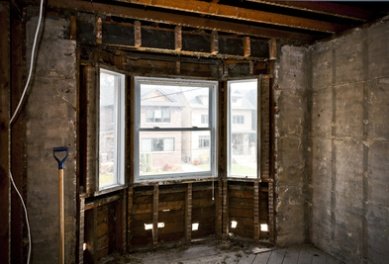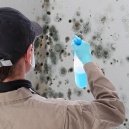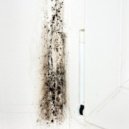Find a pre-screened local mold removal specialist Free Estimate
Find a Mold Specialist Now
Click or Call, Toll-Free 24/7
Mold In Walls
When dealing with wall mold, you have to check for mold in walls, too. It’s very common, when you have mold on your walls, to also find mold inside the walls. If you don’t remove the mold inside walls as well, there’s no point removing the mold on the outside of the walls, since the mold inside the walls will just continue to grow and spread.
How Do You Know if You Have Mold Inside Walls?
You should suspect mold in your walls if:
- There is a significant amount of wall mold on the outside of your walls.
- There has been flooding or other significant water damage in the home.
- You smell a definite musty odor in the room but can’t see any mold (in this case, check air ducts for mold, as well).
The only way to know for sure if there is mold in walls is to look. Cut 12 inch by 12 inch inspection holes with a drywall saw every four feet, remove any insulation, and use a mirror and flashlight to inspect the inside of the walls.
You can also call in a certified mold tester to inspect your home and test different areas for the presence of mold. Certified mold testers are usually engineers and they know how and where to look for mold. They will make sure you don’t overlook any hidden mold in the home. To find certified mold testers in your area, follow the link.
Dealing with Mold in Walls

Before beginning the job of removing mold from the inside of walls, you need to cover doorways, air vents, and other openings to other parts of the home with plastic. If you’re working in a large room, you can use large sheets of plastic to block off a smaller area in which you will be working. This prevents the spread of mold spores to other areas of the home. Mold remediation experts often recommend setting up negative pressure in the work area, as well.
Remove moldy drywall and insulation. Use a spray bottle of water to dampen moldy materials before removing them; this helps prevent mold spores from becoming airborne during the process. When sawing through moldy drywall, you can have an assistant hold a vacuum hose with a HEPA filter nearby to further decrease the spread of mold spores. Enclose moldy materials in heavy plastic garbage bags before carrying it out of the home so no mold spores are spread to other areas of the home in the process. It’s imperative that you do everything possible to prevent spreading mold spores throughout the house so that you don’t end up with mold in other rooms.
If there is any mold on the wooden studs in the wall, clean those as well as you can with an antimicrobial cleanser. Allow them to dry completely, then apply a mold sealant to make sure any remaining traces of mold cannot continue to grow and spread. Do not attempt to sand wooden studs to remove mold; sanding moldy wood should only be done by a professional, since it greatly increases exposure to potentially harmful mold spores and can lead to serious illness.
If you want help removing wall mold, or if you think the wooden studs might need to be sanded, we recommend scheduling a consultation with a mold removal professional. Even if you plan to do the work yourself, you can get some free professional advice, because most mold removal professionals offer free in-home consultations. To find experienced mold removal professionals offering free in-home consultations in your area, just follow the link.
Free Home Inspection By A Mold Removal Specialist
Search This Website
Recent Articles
-
See Our 5 Recommended Mold Removal Companies in Covington, KY
Apr 16, 25 12:59 PM
-
See Our 5 Recommended Mold Removal Companies in Wheaton, IL
Jun 20, 24 10:33 AM
-
See Our 5 Recommended Mold Removal Companies in Aberdeen, SD
Oct 08, 21 04:05 PM




